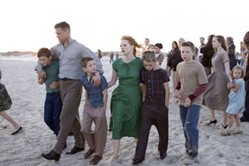Of the several hundred films released during 2011 the following ten were chosen because they do more than just entertain us. They explore the life worth living, and even celebrate the human spirit.
Some will be found on the lists of the secular critics ― six of the top 10 here are Academy Awards “Best Picture” nominees, announced today (Jan. 24) ― but others will be less familiar. Although aesthetics and box office success are considered, the spiritual content of the film is paramount in these rankings.
These are films that challenge us spiritually or morally in dealing with human relationships. A few even suggest that there is an invisible realm, or a Person, greater than ourselves.
The Bible references are from my original reviews, intended to help the reader see a connection between film and Scripture.
1. Tree of Life. Rated PG-13. Job 38:4-7.
Director/writer Terence Malick’s visual meditation was a difficult film for many people to watch because he does not follow the usual narrative form of filmmaking. But as with his The Thin Red Line, Malick is deeply concerned with matters of the spirit, even beginning the film with the quotation from Job in which God speaks of the vastness of his creation. Loosely following the ups and downs of a Texas family with three boys growing up in the 1950s, the episodic film includes a marvelous visual history of the universe from the Big Bang through the rise of the dinosaurs. It even suggests ― in a scene where a large dinosaur is in a position to kill a smaller one but spares it instead ― that grace is embedded in all living beings.
2. Harry Potter and the Deathly Hallows 2. Rated PG-13. Isaiah 53:12ab, Matthew. 16:24-26.
J.K. Rowling’s series is brought to a rousing conclusion in this second part of the darkest of all the filmed novels. Like Christians attending an Ash Wednesday service, Harry has from infancy borne a mark on his forehead, but his will not wash off. Often we have witnessed Harry risking life and limb to help others. This time he is called to suffer and give himself as never before. His long time adversary Lord Voldemort, upon first meeting Harry face to face says, “Harry Potter, the boy who lived... come to die.” This is possibly the most unwitting theological statement in the entire film series. The scene undergirds Ms. Rowling’s statement that she modeled her hero after Jesus Christ. She even provides her version of the doctrine of the Communion of Saints when Harry communes with his dead parents and mentor Professor Dumbledore.
3. Hugo. Rated PG. Psalm 82:3-4, Isaiah 11:6d.
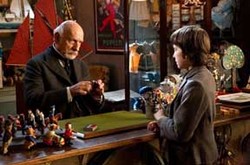
From “Hugo,” Hugo's first meeting with Georges is not a friendly one. —courtesy of Paramount Pictures
Martin Scorsese’s adaptation of the juvenile novel is both a fitting celebration of the pioneers of cinema and the ability of one caring heart to reach out to a broken heart. Hugo is a young orphan secretly living amidst the works of the giant clocks of a Paris train station in the 1930s. Taught by his horologist father, he is trying to repair an automaton, and soon is seeking to fix a broken man as well. The man is Georges Milies, the great filmmaking pioneer, who has fallen into obscurity after going bankrupt. Hugo and Georges, and even several minor characters in the film, discover the joy of companionship, testifying to the Scripture’s insistence that it is not good for a person to live alone. Through his fixing of machine and man, Hugo discovers his life has a purpose.
4. The Descendants. Rated R. Matthew 18:21, Psalm 24:1-2.
Alexander Payne explores in his film themes of family connection, responsibility to one’s heritage as it relates to land, acceptance of death, reconciliation, “emptying” of one’s self for the sake of others (see Philippians 2:5-8) — and thus grace. George Clooney’s Matt King, a real estate lawyer in Hawaii, has his hands full dealing with serious problems. His wife lies in an irreversible coma. He has become estranged from his teenage daughter and her younger sister. He is being pressed by his large clan to sell the family inheritance, a pristine beachfront tract of land that resort developers want to build on. And he learns from his older daughter that his wife had been cheating on him. Through wrestling with all these conundrums, Matt emerges as a compassionate agent of grace.
5. The Help. Rated PG-13. Psalm 148, Proverbs 31:8.
This film of empowering sisterhood manages to be funny and serious at the same time. The African American domestic workers and a young white writer — able to grow beyond her prejudiced heritage — parter to expose the hardship and humiliation blacks must endure while working long hours and short wages for well-off whites in Jackson, Miss. The film also depicts the support of a church that honors those who take risks. Despite criticism that it is not realistic in so few consequences of the servants’ defiance of the racist system, this inspiring film makes a good companion to Lawrence Dunbar’s great poem, “We Wear the Mask.”
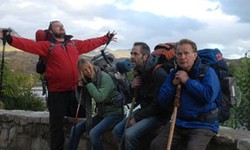
From “The Way”, the grieving Tom Avery and some fellow spiritual pilgrims in northern Spain. —courtesy of Arc Entertainment
6. The Way. Rated PG-13. Proverbs 4:11-13.
Martin Sheen plays a father trying to understand and reconnect with his estranged son (played by his real life son Emilio Estevez, who also wrote and directed) who has died in a storm at the beginning of an intended pilgrimage on El Camino de Santiago in northern Spain. Impulsively, the grief stricken father decides to finish the pilgrimage. He ― and the companions he meets along “The Way,” as the pilgrimage is called ― grows to understand both himself and his son, and thus to reorient his life from a self-centered existence to one focusing on others.
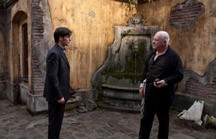
From “The Rite,” Michael and Father Lucas in Rome. —courtesy of Warner Brothers
7. The Rite. Rated PG-13. John 15:16.
Despite its rejection by most secular critics, I found this film worthwhile not only because of its realistic treatment of the rite of exorcism, but even more by the way in which faith and doubt are depicted. A Catholic candidate for the priesthood, who has so many doubts that he plans to resign, is talked into representing his diocese at a class in Rome on the rite of exorcism. There he becomes the reluctant companion of a senior priest engaged in treating demon-possessed victims. The older priest encourages the young man to embrace and learn from his doubts, surely the sign of a faith struggling toward maturity.
8. War Horse. Rated PG-13. Luke 2:13-14.
When an English father foolishly buys a thoroughbred horse for plowing his field, his son works hard to train the high-spirited animal, named Joey, to pull a plow. The bond developed between boy and animal remains strong, even when the father sells the horse to a cavalry officer at the beginning of World War One. There follows a series of adventures, some of them horrendous, as Joey passes through the hands of various soldiers amid the carnage of the war. As usual, director Stephen Spielberg brings out the common humanity to be found on both the British and the German sides of the battle lines.
9. A Better Life. Rated PG-13. Psalm 9:18; Proverbs 4:1-4.
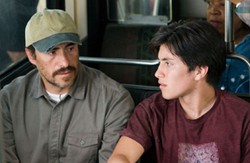
From “A Better Life,” Carlos illegally entered the U.S. years earlier to give his son Luis a better life. —courtesy of Summit Entertainment
Illegal immigration acquires a human face in this moving father-son story. Carlos works long hours at low wages to give teenaged Luis a better life in southern California than was possible in Mexico. When disaster strikes, the once unappreciative son draws closer to Carlos and the culture the boy had been rejecting. Even when all appears hopeless, Carlos, caught and sent back to Mexico, refuses to give in to despair.
10. The Artist. Rated PG-13. Ecclesiastes 9:11-12, 1 Co 13:4a
This almost entirely silent film reminded me of words attributed to Francis of Assisi, “Preach the gospel always; use words if you must.” Writer/director Michel Hazanavicius believes this about dialogue, the characters expressing their emotions though facial expressions, gestures, and an occasionally interspersed title card. Only at the conclusion of the film do we actually hear a word spoken, and then not by the star-crossed lovers. The simple tale of a silent movie actor whose star declines while the young actress, whom he helped get started, rises to stardom with the advent of sound is totally engrossing. Grace and the danger of false pride are explored with such skillful artistry that those calling this a “masterpiece” may well be right.
Also worth watching:
A number of “faith-based” films were released during the year, some of them rising above the level of religious propaganda.
Courageous, the most recent of the films made by Sherwood Baptist Church, is, up to a point, a fine film about fathers accepting their responsibilities. It has one of the best scenes ― in which a pastor moves beyond the usual platitudes over the loss of a child ― but it lacks the subtlety of a true work of art. The main character actually preaches in church at the conclusion.
Dolphin Tale and Soul Surfer are also entertaining, but have appealed mainly to believers.
Other excellent films exploring spiritual and human relationships are: Adjustment Bureau, Buck, Everything Must Go, Incendies, The Music Never Stopped, Super 8, Water For Elephants, and Win Win. A film that I am eager to see because it might have replaced one on the list above is The Mill & the Cross, exploring Pieter Bruegel and his famous painting “The Way to Calvary.”
Edward McNulty, a Presbyterian minister, is author of “Faith and Film” (Westminster John Knox Press, 2007) and other books. He reviews films at www.visualparables.net.

